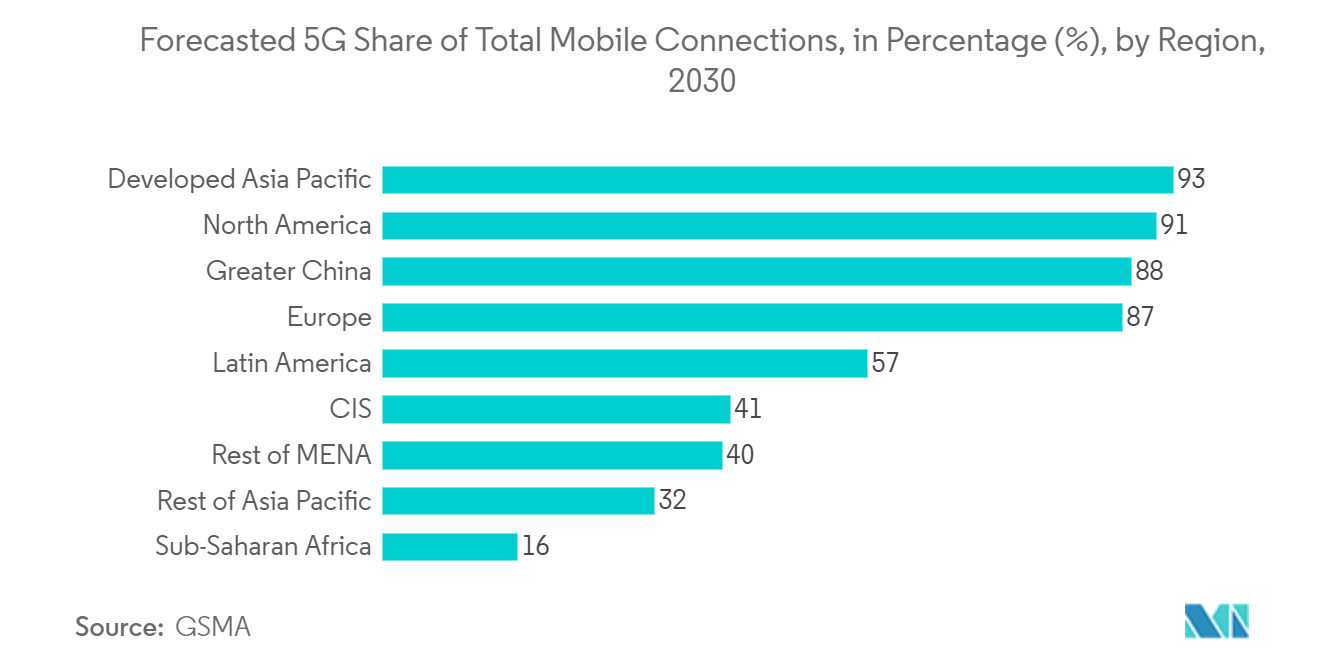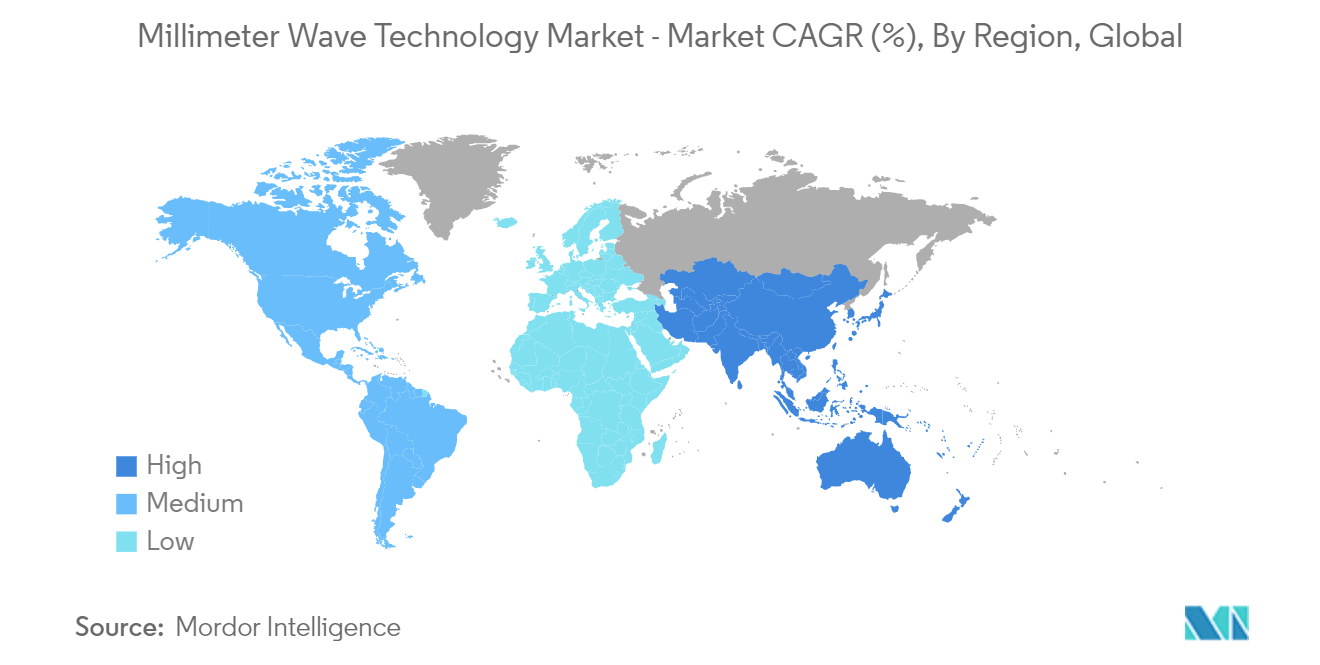Market Trends of Millimeter Wave Technology Industry
Antennas and Transceivers Segment Holds Significant Market Share
- High-performing millimeter-wave devices require efficient low-profile antennas to ensure reliable and interference-free communications, and due to small wavelength, mmWave technology infrastructure requires large antenna arrays to be packed in miniature physical dimensions, which fueling the requirement of antennas and transceivers designed for the millimeter (mm) wave technology, fueling the market growth.
- The higher data transfer rate of the mmWave technology has various uses in real-time gaming, high-quality video streaming, and other bandwidth-intensive applications, which require antennas and transceivers for relaying and transforming the signals, creating a demand for microstrip, on-chip integrated horn, lens, and reflector, and other antennas for mmWave technology.
- According to a recent GSMA report, 5G adoption is anticipated to reach around a billion connections by 2030. The technology will likely underpin future mobile innovation and boost ongoing deployments, adding almost USD 1 trillion to the global economy in 2030. The report states that throughout 2023, 30 new markets across Africa and Asia will launch 5G services. As 5G adoption continues to scale, network operators are increasing their efforts to expand their 5G fixed wireless access (FWA) offerings. Markets with low fixed broadband penetration and rising incomes will also see faster-than-average 5G growth.
- Market vendors are undergoing strategic initiatives to expand antennas and transceivers' product portfolio for mmWave technology applications and hold a major market share. For instance, in October 2023, Malaysia's 5G network operator, Digital Nasional Berhad (DNB), partnered with Telekom Malaysia (TM) and Chinese vendor ZTE Corporation to conduct a 5G live trial which would deliver speeds up to 28 Gbps. ZTE stated that this partnership was expected to help leverage TM's established network infrastructure, digital expertise, and ZTE's mmWave active antenna unit to deliver the first standalone 5G core of Malaysia for the next-generation transport network.
- In August 2023, Marki Microwave, a provider of radio frequency and microwave products, acquired the waveguide business of Precision Millimeter Wave LLC, a supplier of sub-THz waveguide technology. Marki Microwave plans to offer over 100 standard commercial waveguide products and multiple custom waveguide products like mmWave to sub-THz, including antennas, connectors, switches, and isolators.
- The need for high-speed communications in various end-user applications and the need for phase antennas and highly capable transceivers for mmWave communication add growth to the market, which is supported by acquisitions, investments, and collaborations among the millimeter wave technology market stakeholders.

North America is Expected to Hold Significant Market Share
- The United States has made significant strides in utilizing the millimeter wave spectrum for various applications. Regulatory bodies like the Federal Communications Commission (FCC) have allocated and auctioned millimeter wave frequency bands for licensed and unlicensed use. Notably, the FCC opened spectrum in the 28 GHz, 37 GHz, 39 GHz, and 47 GHz bands for 5G and other wireless communication technologies.
- The rollout of 5G networks in the United States has driven the adoption of millimeter wave technology. Moreover, Viavi Solutions, an Arizona-based network test and measurement company, stated that the United States was one of the significant global countries with the most cities adopting network access.
- For instance, as of April 2023, around 503 cities adopted 5G network access in the country. China followed in second, with 5G availability in 356 cities. As a result, millimeter wave frequencies are a key component of 5G, particularly in deploying high-speed, low-latency 5G networks in urban areas. Telecom companies have been actively deploying 5G infrastructure that includes millimeter wave spectrum to deliver ultra-fast internet speeds and support emerging use cases like augmented reality (AR), virtual reality (VR), and IoT.
- According to CTIA (July 2023), the United States was the leading country in the world to deploy 5G, with more 5G accessibility than any other nation. 5G’s more responsive networks and faster speeds drive strong enterprise and consumer adoption. The wireless sector is distributing 5G ahead of schedule, capitalizing records and world-leading capital amounts to deploy 5G faster than any preceding generation of wireless.
- It is expected that 5G will eventually add USD 1.5 trillion to the nation’s economy and create new jobs (at least 4.5 million). 5G networks across the country already cover over 325 million individuals, giving the world’s most accessible 5G networks. Ookla places the United States as the world leader in accessibility, with more than 54% of connections from 5G-capable handsets linking to a 5G network most of the time.
- Canada has made substantial strides in leveraging the millimeter wave spectrum for various applications. Regulatory authorities, such as Innovation, Science, and Economic Development Canada (ISED), allocate and control the use of millimeter wave frequencies for licensed and unlicensed purposes. Frequencies in the 26 GHz, 28 GHz, 38 GHz, and other bands are significant assets for millimeter wave applications.
- Moreover, the country’s rising need for 5G networks that leverage millimeter wave frequencies to deliver ultra-fast internet speeds and low latency is increasing. For instance, according to Ericsson reports, as of November 2022, in the upcoming 12 to 15 months, four million Canadian smartphone users intend to upgrade to 5G service. Additionally, only a third of Canadian 5G users believe they are connected to the network more than 50% of the time, while 45% of users still stated they have coverage concerns. Such significant concerns are anticipated to focus on deploying high-frequency radio waves in the millimeter wave spectrum to capture the growing demand.


